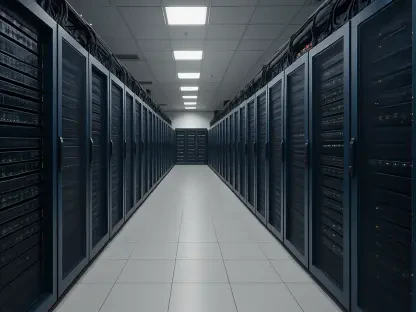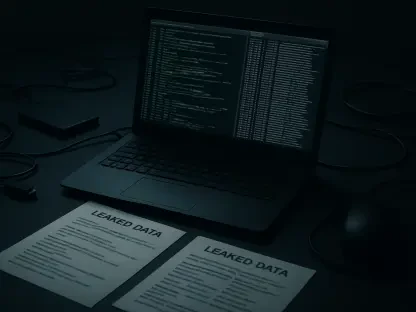The recent annual review published by the National Cyber Security Centre (NCSC), an offshoot of GCHQ, highlights a significant increase in cybersecurity threats facing the United Kingdom. This review, covering the period from September 2023 to August 2024, indicates that the number of incidents reaching the NCSC’s maximum severity threshold has tripled compared to the previous year. The report stresses the urgency and severity of these threats, which, according to NCSC board members, are widely underestimated and outpacing the nation’s ability to defend against them.
Rising Number of High-Severity Cyber Incidents
Escalating Threat Landscape
The NCSC’s review reveals a dramatic rise in high-severity cyber incidents. In the period under consideration, the NCSC classified 12 incidents as maximally severe, a notable increase from the previous year. Out of the total 430 cases requiring support from the Incident Management (IM) team, a 16 percent increase was observed year-over-year. This growing number of critical incidents underscores the escalating cyber risk landscape in the UK. The severity and frequency of these incidents are a clear indicator that the threat landscape is becoming increasingly complex and formidable.
The reality is that cyber threats are not just increasing in volume but also in their level of sophistication. Organizations are facing a variety of attacks ranging from data breaches to malware and sophisticated phishing schemes. The troubling aspect is that many of these threats are coming from well-resourced and highly skilled adversaries, making it even harder for organizations to fend off these attacks effectively.
Zero-Day Vulnerabilities
Adding to the concern is the rise in nationally significant incidents, which grew from 62 to 89 over the year, with six incidents specifically attributed to the exploitation of zero-day vulnerabilities in Palo Alto and Cisco systems (CVE-2024-3400 and CVE-2023-20198). Zero-day vulnerabilities are those previously unknown flaws in software that cybercriminals exploit before developers are able to patch them. These vulnerabilities represent a particularly dangerous class of threats because there is essentially no advance warning, leaving systems exposed until the point of detection and resolution.
The exploitation of zero-day vulnerabilities highlights the gaps in current security postures and the pressing need for more proactive and comprehensive vulnerability management strategies. Organizations need to incorporate regular security assessments, timely patch management, and continual monitoring to swiftly identify and mitigate these vulnerabilities before malicious entities can exploit them. By focusing on these measures, organizations can enhance their resilience against a landscape riddled with ever-evolving threats.
Increase in Ransomware Attacks
Prevalence and Impact
The review states that 347 incidents involved data exfiltration and extortion, with 317 of these cases being ransomware attacks. This marks a rise from 297 ransomware incidents in the previous year, demonstrating the growing prevalence of this threat. Ransomware attacks have significant impacts on organizations, often leading to financial losses, operational disruptions, and reputational damage. These attacks typically involve encrypting a victim’s data and demanding a ransom for the decryption key, placing severe pressure on businesses to comply to restore their operations quickly.
The implications of ransomware are far-reaching, impacting industries across the board. Healthcare, education, finance, and manufacturing sectors have all reported substantial disruptions due to ransomware attacks. The increasing complexity and effectiveness of these attacks often leave organizations with no choice but to pay the ransom, which not only fuels more attacks but also emboldens cybercriminals, making the cybersecurity landscape even more hostile.
Organizational Vulnerabilities
The increasing number of ransomware attacks highlights the vulnerabilities within organizations’ cybersecurity defenses. Many organizations are still not adequately prepared to defend against these sophisticated attacks, which often exploit weaknesses in security protocols and employee awareness. For instance, attackers frequently gain initial access to systems through phishing emails that deceive employees into providing login credentials or downloading malicious attachments. Once inside the network, cybercriminals can move laterally, deploy ransomware, and extract sensitive data.
To mitigate these risks, organizations must prioritize strengthening their cybersecurity posture by implementing robust security measures. This includes regular cybersecurity training for employees, ensuring up-to-date antivirus and anti-malware software, and employing advanced threat detection systems. Additionally, maintaining regular data backups is critical to minimize the impact of ransomware attacks, allowing organizations to restore affected systems without succumbing to ransom demands.
Gap Between Threat Exposure and Defenses
Urgent Need for Enhanced Cybersecurity Measures
The NCSC review highlights the concerning gap between the current level of threat exposure and the defenses in place to combat these threats. Richard Horne, the NCSC’s new CEO, stresses that the UK needs to increase the pace of its cybersecurity efforts to keep ahead of adversaries. The review calls for concerted efforts from both public and private sectors to build cyber resilience, implementing the NCSC’s advice, guidance, and frameworks more effectively and broadly. The increasing complexity of threats necessitates a swift and comprehensive response from all stakeholders involved in safeguarding national cybersecurity.
The urgency to bridge this gap cannot be overstated, as procrastination will only exacerbate the existing vulnerabilities. The NCSC’s frameworks and guidance provide a solid foundation; however, their effectiveness depends on rigorous and widespread adoption. This involves not just technical measures but also strategic planning and governance to ensure that cybersecurity policies are integrated into the core operational fabric of organizations.
Public and Private Sector Collaboration
The review emphasizes the need for collaboration between the public and private sectors to enhance cybersecurity measures. By working together, these sectors can share knowledge, resources, and best practices to build a more resilient cybersecurity infrastructure. Public-private partnerships can accelerate the development and deployment of innovative security solutions, with the public sector providing regulatory support and the private sector contributing technological advancements and implementation expertise. This collaboration is vital in addressing the multifaceted nature of cyber threats, which no single entity can tackle alone.
Furthermore, fostering a culture of openness and communication between the sectors can lead to more effective threat intelligence sharing and collaborative defense strategies. By leveraging collective expertise and resources, stakeholders can develop a unified approach to cybersecurity, ensuring that all parties are well-equipped to counter the evolving threat landscape. The long-term goal is to create a robust, adaptable, and forward-looking cybersecurity ecosystem capable of withstanding the challenges posed by increasingly sophisticated adversaries.
Evolving Cyber Intrusion Ecosystem
Future Projections
The review identifies a clear trend of increasing cyber threats and the growing sophistication of cybercriminals. The projection of a future cyber intrusion ecosystem by 2030, where highly capable tools become accessible to both seasoned adversaries and less sophisticated criminals, underscores the evolving threat landscape. This predicted ecosystem indicates a lowering barrier to entry into the world of cybercrime, making it more challenging to defend against potential threats. This scenario suggests that cybercrime could become more democratized, with high-powered attack capabilities falling into the hands of a broader range of threat actors.
As we approach 2030, it is crucial for the cyber defense community to anticipate these changes and develop adaptive strategies to stay ahead of malicious actors. This requires a forward-thinking approach that considers not just current threats but also future trends and technologies that could reshape the cybersecurity environment. A proactive stance will be essential to preempt and mitigate the impact of emerging threats in an increasingly interconnected world.
Role of Artificial Intelligence
Artificial intelligence (AI) is another critical factor in shaping the future threat landscape. The review suggests that AI will intensify the complexity of cyber threats and empower adversaries. Cybercriminals can leverage AI to develop more advanced and persistent attack methods, automate repetitive tasks, and even identify and exploit vulnerabilities with unprecedented speed. This, coupled with an insecure global supply chain, creates a precarious environment for cybersecurity efforts. As AI technologies continue to advance, they will undoubtedly play a dual role, empowering both defenders and attackers in the ongoing cybersecurity battle.
On the one hand, AI can significantly enhance defensive measures, enabling automated threat detection, predictive analytics, and rapid response capabilities. On the other hand, malicious actors can use the same technologies to refine their tactics and evade traditional security measures. As a result, organizations must invest in AI-driven cybersecurity solutions while remaining vigilant about the potential misuse of these technologies by adversaries. Navigating this delicate balance will be a key challenge in the coming years.
State-Sponsored Cyber Activity
Threats from China and Russia
The report also highlights the persistent threat from state-sponsored cyber activity, particularly from countries like China and Russia. GCHQ and NCSC officials have repeatedly emphasized that China remains a sophisticated cyber actor with ambitions beyond its national borders. China’s cyber activities encompass a broad range of tactics, including espionage, intellectual property theft, and infrastructure disruption. These actions are often aimed at gaining a strategic advantage over other nations, particularly in areas of economic and military significance.
Similarly, Russian cyber activity continues to pose a significant threat, with state-sponsored and ideologically driven attacks targeting Western critical national infrastructure (CNI). Russian entities have been linked to a number of high-profile cyberattacks, including those aimed at disrupting energy grids, financial systems, and government networks. The motivations behind these attacks range from geopolitical maneuvering to economic gain and domestic influence.
Defensive Measures
To counter these state-sponsored threats, the NCSC calls for robust defensive measures. This includes enhancing threat intelligence, improving incident response capabilities, and strengthening international cooperation to address the global nature of cyber threats. Effective defense requires a multi-faceted approach that combines technology, policy, and collaboration to create a resilient cybersecurity framework. Stronger threat intelligence capabilities enable organizations to detect and respond to attacks more swiftly, reducing the window of opportunity for malicious actors.
Furthermore, incident response plans must be regularly updated and tested to ensure they are effective in real-world scenarios. Organizations should also foster partnerships with international counterparts to share threat information and coordinate defense efforts. By strengthening these alliances, the global community can more effectively counteract the sophisticated campaigns of state-sponsored adversaries, ensuring a collective defense against common threats.
Call to Action
Viewing Cybersecurity as a Business Investment
The NCSC’s review consistently stresses the urgent need for enhanced cybersecurity measures. Richard Horne’s statements reflect a commitment to closing the gap between exposure and defense, while also calling on organizations to view cybersecurity as a critical business investment rather than a compliance burden. By prioritizing cybersecurity, organizations can protect their assets, maintain customer trust, and drive growth. Horne’s approach highlights the intrinsic value of cybersecurity in safeguarding business continuity and creating a competitive edge in today’s digital economy.
Investing in cybersecurity should be perceived not just as a defensive strategy but as an enabler of innovation and growth. A robust cybersecurity posture can enhance customer confidence, open new market opportunities, and ensure regulatory compliance. As cyber threats continue to evolve, integrating cybersecurity into the core business strategy will be fundamental to long-term success and sustainability.
Implementing NCSC Guidance
The recent annual review by the National Cyber Security Centre (NCSC), a branch of GCHQ, reveals a major surge in cybersecurity threats targeting the United Kingdom. This comprehensive review spans from September 2023 to August 2024 and shows that the incidents hitting the NCSC’s highest severity level have tripled compared to the previous year. The report accentuates the increasing urgency and gravity of these dangers, which NCSC board members claim are broadly underestimated and progressing faster than the UK can defend against. The escalating threat landscape includes not just the rise in sheer numbers but also the complexity and sophistication of cyber-attacks. These attacks strain both public and private sector resources, pushing the limits of existing cybersecurity defenses. Without significant advancements in cybersecurity measures, the nation’s critical infrastructure, financial sectors, and even individuals remain at elevated risk. The NCSC’s findings underscore the critical need for enhanced cybersecurity strategies and investments to mitigate these evolving threats effectively.









